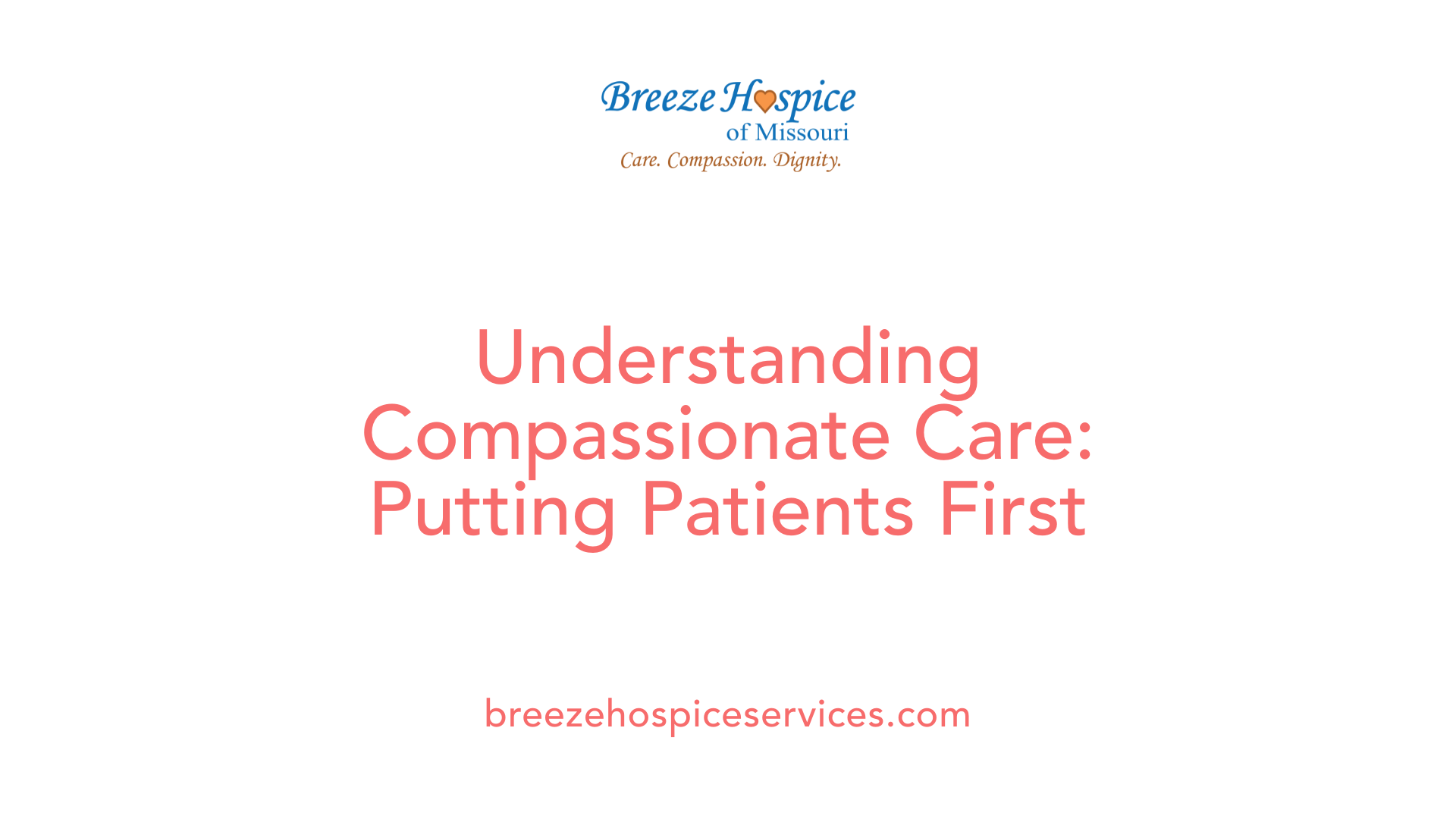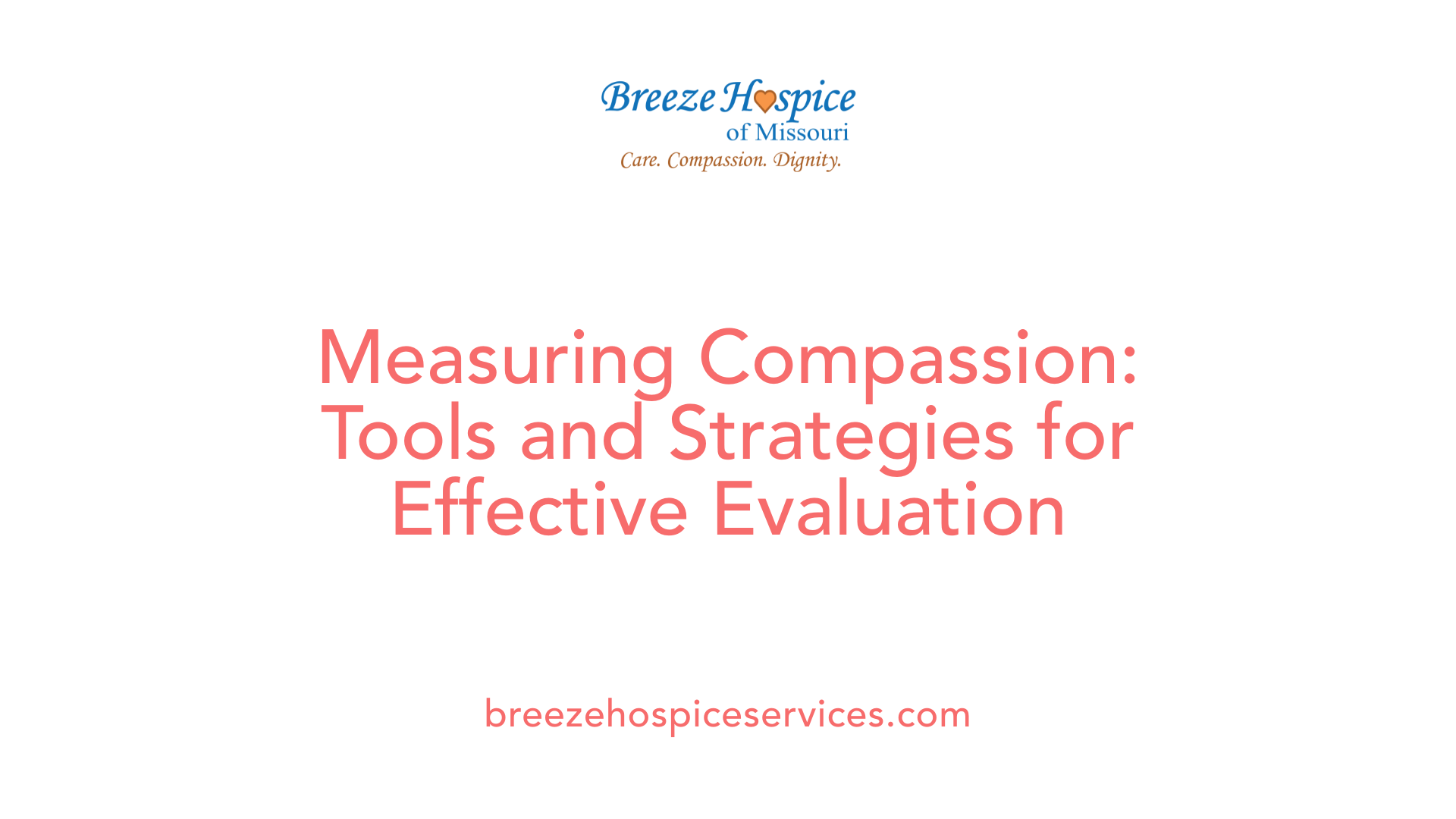Developing Policies for Compassionate Care
July 25, 2025
Fostering Compassionate Policies in Healthcare: A Path to Human-Centered Care

Understanding and Implementing Compassionate Care in Healthcare Settings
Developing effective policies for compassionate care is essential for enhancing patient experiences, safety, and outcomes while supporting healthcare professionals’ well-being. This article explores foundational principles, leadership approaches, strategies, challenges, and evaluation methods involved in creating and sustaining compassionate care policies across healthcare organizations.
Foundations of Compassionate Care in Healthcare

What is compassionate care in healthcare?
Compassionate care is a holistic, patient-centered approach that emphasizes recognizing, understanding, and emotionally resonating with the concerns and suffering of patients. It involves seeing patients as whole persons with unique emotional, psychological, and physical needs, rather than just focusing on their medical condition.
Healthcare professionals demonstrating compassion actively listen, show kindness, and communicate effectively to reassure and support patients. This approach respects cultural differences and personal values, fostering trust and reducing anxiety during vulnerable moments.
Providing compassionate care benefits both patients and providers. Patients experience increased satisfaction, safety, and better health outcomes. For healthcare workers, it enhances their resilience, job satisfaction, and overall well-being.
Fundamentally, compassionate care aims to uphold the dignity and humanity of each individual, ensuring healthcare is not only effective but also humane. It is embedded in professional standards and codes of practice, emphasizing that kindness, empathy, and respect are vital components of quality healthcare.
Leadership and Organizational Culture for Compassionate Care

What approaches do leadership in healthcare take to foster a culture of compassion?
Healthcare leadership plays a pivotal role in cultivating a compassionate organizational environment. They foster this by exemplifying empathetic behaviors such as active listening, demonstrating understanding, and providing support to both staff and patients. Leaders strive to embed compassion into the core organizational values through comprehensive staff training programs and by adopting empathy-centered hiring practices.
Reimagining care processes to prioritize patient experiences and voices is another essential strategy. Leaders facilitate open communication channels, promote transparency, and uphold accountability, which nurtures trust within the organization. Recognizing and rewarding compassionate behaviors among staff reinforces a caring culture, motivating continuous engagement and high-quality interactions.
Moreover, policies that support compassionate principles, such as dedicated time for reflection and emotional resilience training, help sustain a caring environment. By fostering an atmosphere where staff feel valued and supported, leadership enhances not only patient outcomes but also staff well-being, creating a resilient and compassionate healthcare setting.
Interdependence of culture and leadership
A modern understanding recognizes that organizational culture and leadership are deeply interconnected. They influence each other dynamically, shaping shared behaviors, attitudes, and norms. Effective leadership actively co-develops a culture that champions compassion, embracing models like transformational and servant leadership that emphasize altruism, trust, and collective well-being.
Strategies to foster a culture of compassion
Creating a culture of compassionate care involves several strategic actions:
- Inspiring visions that align with compassionate principles.
- Ensuring objectives support staff engagement and patient-centeredness.
- Embed learning and innovation as part of everyday practices.
- Strengthen teamwork through collaborative practices.
- Support continuous professional development focusing on emotional intelligence and resilience.
These strategies create a supportive climate where compassionate behaviors are embedded into daily routines.
Overcoming barriers such as burnout and bureaucratic hurdles
Healthcare settings face barriers like burnout, time pressures, bureaucratic distractions, and complex clinical scenarios that hinder compassionate care. To address these, organizations can nurture intrinsic motivation and promote self-compassion among staff. Emotional resilience programs, supportive supervision, and recognizing staff efforts are vital.
Reducing bureaucratic burdens by streamlining processes frees time for meaningful patient interactions. Promoting collective noticing and responding to suffering enhances empathy and compassion. Ultimately, overcoming these challenges requires organizational commitment to prioritize staff well-being, foster trust, and support continuous learning—all rooted in a shared vision of compassionate, patient-centered care.
Strategies and Frameworks for Policy Development

How can healthcare policies be developed to support compassionate care?
Developing effective policies that promote compassionate care requires thoughtful principles and a multi-layered approach. At the core, policies should be grounded in evidence-based practices that prioritize patient dignity, safety, and well-being. It is important for policymakers to incorporate empirical data, such as research from credible sources like the NCBI Bookshelf, which highlights the importance of empathy and patient-centered care.
Creating policies that support compassion involves engaging frontline healthcare staff in the development process. Their insights ensure that policies are practical, relevant, and address real-world challenges like burnout, time pressures, and organizational constraints. Encouraging staff participation also fosters ownership and commitment to compassionate standards.
A successful framework operates at multiple levels — from organizational to national — adopting a system-wide perspective. Integrating compassion into national health policies helps set a shared vision, while organizational policies can reinforce these values through specific standards, training, and accountability mechanisms.
Embedding compassion into organizational culture is essential. Policies should promote continuous learning, supportive supervision, and mechanisms that recognize and reward compassionate behaviors. Actions like fostering teamwork and emotional resilience contribute to sustainable change.
Furthermore, policies should be adaptable to local contexts, considering resource availability, cultural factors, and system-specific needs. Incorporating feedback loops allows organizations to refine approaches based on ongoing evaluation and patient outcomes.
Ultimately, developing healthcare policies that support compassionate care involves aligning ethical principles with scientific evidence, actively involving staff and patients, and implementing strategies across all system levels. This comprehensive approach nurtures a healthcare environment where compassion is not an add-on but a fundamental value.
Strategies include:
- Promoting staff training in compassionate communication and relational skills.
- Developing organizational standards for compassionate practices.
- Incorporating compassion metrics in quality improvement initiatives.
- Ensuring policies support work conditions that prevent burnout.
- Embedding compassion into accreditation and regulatory requirements.
Creating robust, evidence-informed policies helps healthcare systems effectively foster a culture of compassion, ultimately improving patient outcomes and provider well-being.
Training, Measurement, and Evaluation of Compassionate Care Policies

How is the effectiveness of compassionate care policies measured and evaluated?
Assessing the impact of compassionate care policies is vital for ensuring they deliver meaningful improvements in healthcare. Several validated measurement tools are used to evaluate both patient perceptions and healthcare provider behaviors.
One prominent instrument is the Sinclair Compassion Questionnaire (SCQ), which captures patient-reported levels of perceived compassion. Its high reliability and validity have been established through rigorous psychometric testing, such as factor analysis and internal consistency measures. The SCQ provides insights into how compassionate care is experienced from the patient’s perspective.
In addition to patient feedback, observational assessment tools like the Collaborative Behaviors Observational Assessment Tool (CBOAT) are employed. These tools involve trained evaluators observing healthcare professionals during simulations or real interactions to assess behaviors indicative of compassion, such as active listening, empathy, and respectful communication.
Another valuable instrument is the Compassionate Care Assessment Tool (CCAT), which focuses on direct patient feedback regarding specific caring attributes and meaningful connections made during care episodes. Its design emphasizes capturing the relational and emotional components central to compassionate care.
Using a combination of these instruments allows organizations to get a comprehensive picture of how policies influence actual care practices. Data collected can reveal areas of strength and aspects needing improvement, guiding targeted staff development and organizational change.
Overall, the evaluation integrates patient surveys, behavioral observations, and organizational assessments, providing a multifaceted view of policy effectiveness. Regular monitoring helps sustain progress and adapt strategies to foster a culture where compassion is embedded in everyday practice.
Challenges and Opportunities in Policy Development for Compassionate Healthcare

What are common challenges faced when developing policies for compassionate healthcare?
Implementing effective policies to promote compassionate healthcare encounters several obstacles. One major barrier is the organizational environment, where high workloads and staffing shortages often leave little time for healthcare professionals to engage in compassionate interactions. Routine task-focused culture can diminish the emphasis on relational care, making compassion an afterthought rather than a standard practice.
Sociocultural factors also play a significant role. Societal norms, cultural expectations, gender roles, and language differences can influence how compassion is expressed and perceived. These elements can sometimes hinder the development of universal policies that are culturally sensitive and effective.
Furthermore, gaps in training and organizational support hinder staff from feeling prepared and empowered to deliver compassionate care consistently. Without ongoing education, coaching, and a supportive environment, healthcare providers may struggle to integrate compassion into their daily routines.
Measuring compassion objectively poses additional challenges. Since compassionate care is inherently subjective, developing reliable metrics to evaluate its presence and quality is complex. This measurement difficulty hampers policy development because it complicates efforts to monitor, incentivize, and improve compassionate practices.
In summary, the overlaps between organizational limitations, cultural influences, training gaps, and measurement issues create a challenging landscape for policymakers aiming to embed compassion deeply into healthcare systems.
| Challenge Type | Specific Barrier | Impact on Policy Development |
|---|---|---|
| Organizational | High workloads, staffing shortages | Limits time and resources for compassionate care |
| Sociocultural | Norms, communication barriers | Affects acceptability and effectiveness of policies |
| Training and Support | Lack of ongoing education and leadership support | Reduces staff capability and confidence in providing compassion |
| Measurement Difficulties | Lack of reliable methods to evaluate compassion | Hampers policy monitoring and evaluation efforts |
Developing policies that address these multifaceted challenges requires a comprehensive, adaptable approach. Incorporating innovative strategies and fostering organizational cultures that prioritize compassion can help overcome these barriers and facilitate the delivery of truly compassionate healthcare.
Integrating Compassionate Care into Practice for Improved Outcomes
How do healthcare professionals develop and implement compassionate care plans?
Compassionate care plans are designed to prioritize empathy, respect, and holistic well-being. Developing these plans begins with thorough assessments that explore a patient’s emotional, psychological, and social needs. This process includes gathering information about personal preferences, values, and individual goals to tailor care effectively.
Healthcare professionals use strong interpersonal skills and foster trust to understand their patients better. They focus on active listening, clear communication, and demonstrating genuine concern. These attributes help in creating a care plan that feels personalized and supportive.
Implementation of compassionate care involves more than just writing a plan. It requires delivering care with empathy, ensuring a respectful environment, and maintaining flexibility to adapt as patient needs evolve. Continuous feedback and regular reassessment help refine the plan, ensuring it remains relevant and effective.
Benefits of well-developed compassionate care plans include enhanced patient satisfaction, faster recovery times, and shorter hospital stays. They also promote stronger relationships between patients and providers, fostering trust and cooperation.
Despite these advantages, challenges such as time pressures and limited resources can hinder execution. To address these barriers, organizations must support staff through ongoing training, adequate staffing, and a culture that values compassion as a core component of quality care.
In summary, developing and implementing compassionate care plans requires deliberate effort, organizational backing, and a commitment to continuous learning. When well executed, they lead to better health outcomes and a more humane healthcare experience for both patients and staff.
Moving Forward with Compassionate Care
Developing and operationalizing policies for compassionate care is a complex, multidimensional process requiring leadership commitment, organizational change, evidence-based strategies, and ongoing evaluation. Priority should be given to fostering a culture that values empathy, respect, and human dignity, supported by training, resource allocation, and feedback mechanisms. Overcoming barriers like burnout and organizational inertia is essential for sustaining compassionate practices. As healthcare continues to evolve with technological advances and shifting societal expectations, policies must also adapt to uphold compassion as a central pillar of quality care. By integrating principles across all levels—individual, organizational, and system-wide—healthcare systems can realize the full potential of compassionate care, leading to better health outcomes, higher patient satisfaction, and more resilient healthcare providers.
References
- Developing compassionate leadership in health care: an integrative ...
- Compassionate Care - American Association of Colleges of Nursing
- Creating a Culture of Compassionate Care and Safety - Starling Minds
- Health workforce governance for compassionate and respectful care
- Creating a Comprehensive Compassionate Care Plan
- Compassionate Care Act of 2024 Introduced in Congress
- Enabling the flow of compassionate care: a grounded theory study
- Critical compassion: Affect, discretion and policy–care relations



































































































